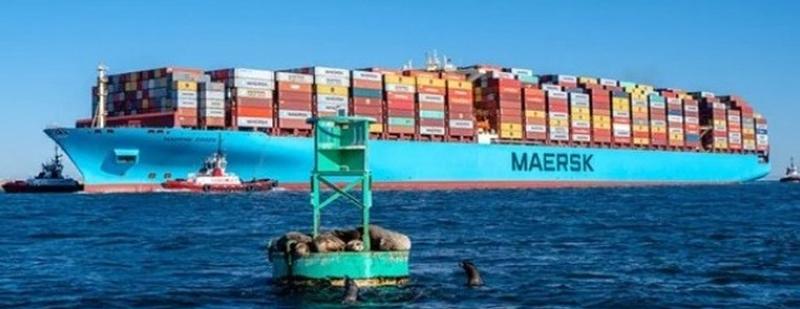 In what is developing into a record winter for containers lost over the side, the Maersk Essen lost 750 containers overboard during a storm on January 16. An unknown number of boxes were damaged but still onboard. The loss occurred when the 13,100 TEU capacity ship on route from Xiamen, China to the port of Los Angeles, USA, reportedly during severe weather.
In what is developing into a record winter for containers lost over the side, the Maersk Essen lost 750 containers overboard during a storm on January 16. An unknown number of boxes were damaged but still onboard. The loss occurred when the 13,100 TEU capacity ship on route from Xiamen, China to the port of Los Angeles, USA, reportedly during severe weather.
This is the third major loss of containers overboard in the Pacific in the past 90 days. At the end of October, the 14,052 TEU ONE Aquila, bound for Long Beach, lost 100 containers over the side in a storm. Then in late November, the sister ship ONE Apus lost a record of almost 1,900 containers in a North Pacific storm.
The loss on the Maersk Essen ranks as the second-worst number of boxes lost overboard, behind only the ONE Apus. Prior to the ONE Apus casualty, the previous record loss of containers overboard was on the Svendborg Maersk which lost 517 containers in heavy weather in the Bay of Biscay in 2014.
For context, the World Shipping Council, an association of the major container shipping companies, representing 80% of the total global vessel container capacity, states that ships of its members, in total worldwide, lost an average of 1,382 containers annually during the period 2008-2019. Over just the last three months, these three casualties alone have resulted in the loss of 2,750 containers, or roughly twice the recorded yearly average of boxes lost.

They need to find a solution to this problem which will probably involve building better and more expensive ships. Or make containers like Lego bricks and use a Flemish bond when stacking.
Jean-Pierre: …make containers like Lego bricks and use a Flemish bond when stacking.
Velcro. Magnets. Better yet, electromagnets!
Larger container ships are being deployed in context of increasing wave height, particularly during the more extreme storms. Or, so scientific research on the topic seems to indicate. It’s hard to say if this is significant at this point. Indicators are that wave heights will increase quite a bit over the next few decades. Presumably architects are tracking this.
“Global trends in wind speed and wave height”
https://science.sciencemag.org/content/332/6028/451.abstract
“Waves and climate change in the north‐east Atlantic”
https://agupubs.onlinelibrary.wiley.com/doi/full/10.1029/2005GL025113
Etc.
(standard for any mention of climate change online: if one disagrees, one has to bring better research citations; personal opinions on this matter mean nothing)
Doug,
I posted this link on the following article but it is probably more relevant here with yours.
https://m.youtube.com/watch?v=dgxe7S1AXEY
That’s a fascinating presentation, Peter. Thanks!